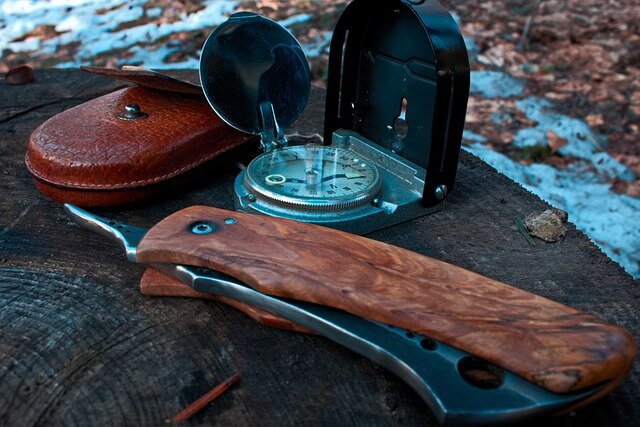Survival Tools

Introduction to Survival Tools
Survival tools are essential for anyone venturing into wilderness environments, outdoor adventures, or emergency preparedness situations. These tools focus on providing the necessary equipment to ensure safety, navigation, food procurement, and shelter in unpredictable conditions.
Key survival tools often include:
- Multi-tools: Compact devices combining knives, pliers, screwdrivers, and more.
- Fire starters: Matches, lighters, or ferro rods for creating fire.
- Water purification: Filters or tablets to ensure safe drinking water.
- Navigation: Compass, maps, or GPS devices for orientation.
- First Aid Kits: Essential for treating injuries on the go.
Explore our guides for the full list of survival essentials!
How important are the brands when it comes to Survival Tools? Or where they're made?
When it comes to survival tools, brands and where they’re made can be significant for a few reasons:
- Quality and Durability: Reputable brands are more likely to offer tools made from durable materials that won’t fail in critical situations.
- Warranty and Support: Established brands often come with warranties or customer service for repairs or replacements.
- Materials: Tools made in regions known for quality craftsmanship (e.g., certain countries known for steel production) can provide an extra level of confidence.
However, personal research and reviews are crucial, as lesser-known brands may still offer excellent performance.
How should I maintenance my Survival Tools?
Maintaining your survival tools is crucial to ensure their longevity and effectiveness when you need them most. Here are some key maintenance tips:
- Clean After Each Use: Wipe down tools to remove dirt, debris, or moisture. This prevents rust and corrosion.
- Sharpen Blades: Regularly sharpen knives, axes, and multitool blades to keep them functional.
- Oil Moving Parts: For tools with hinges or mechanical components, apply light oil to keep them operating smoothly.
- Store Properly: Keep tools in a dry, protected place. Use sheaths or covers for blades.
- Inspect Regularly: Periodically check for wear and damage, replacing or repairing as needed.
Proper maintenance will ensure your survival tools are always ready when you need them.
Can I make money in Survival Tools?
Yes, you can make money in survival tools through various avenues, such as:
- Selling Survival Gear: Launching an e-commerce store that sells curated survival kits, tools, or custom-made items like knives or multitools.
- Affiliate Marketing: Promoting survival tools from brands and earning commissions through affiliate links.
- Creating Educational Content: Offering courses, guides, or books on survival techniques, tool usage, or wilderness preparedness.
- Consulting or Training: Providing in-person or online survival training and workshops for enthusiasts or emergency preparedness groups.
These options can tap into the growing interest in outdoor survival and emergency readiness.
Real-World Survival Tool Situations
Real-World Survival Tool Situations showcase the importance of being prepared with the right gear when faced with unexpected or challenging environments. Some examples include:
- Camping/Hiking Emergencies: A multitool, firestarter, or water filter can be lifesavers if stranded or facing rough conditions.
- Natural Disasters: Items like an emergency radio, flashlight, and first-aid kit are essential during hurricanes, earthquakes, or floods.
- Vehicle Breakdowns: A compact survival kit with jumper cables, a flashlight, and a multitool can help with roadside emergencies.
These scenarios highlight how survival tools play a critical role in everyday and extreme situations.
Is a starting general Survival Toolkit expensive?
Starting a general survival toolkit can range from $150 to $600, depending on the quality and range of tools included. Here’s a quick breakdown:
- Multitool: $25 – $200
- Fire Starter Kit: $10 – $30
- First Aid Kit: $20 – $50
- Knife/Machete: $30 – $150
- Water Filtration System: $20 – $80
- Shelter Supplies (tarp, paracord): $20 – $50
- Backpack: $25 – $150
Start with essentials and gradually expand your toolkit based on your survival goals and needs.
Essential Tools for Survival Situations
Essential tools for survival situations include:
- Multitool: Combines several tools like knives, pliers, and screwdrivers in one compact device.
- Survival Knife: A sturdy, versatile blade for cutting, hunting, or self-defense.
- Fire Starter: Ensures you can make fire in any conditions, like a flint striker or waterproof matches.
- Water Filtration System: Helps purify water from natural sources.
- First Aid Kit: Essential for treating injuries.
- Paracord: Durable rope for shelter, gear repairs, or traps.
- Shelter Materials: Compact tarp or emergency bivy for protection from the elements.
- Compass & Map: For navigation without relying on electronics.
Safety Survival Tools? Or things that should be in the kit often forgotten...
Educational Resources for Survival Toolkits
Here are some Educational Resources for Survival Toolkits:
- REI Co-op – Offers expert advice on survival gear and tips for wilderness preparedness. REI Survival Guide
- Outdoor Life – Features articles on essential survival tools and techniques. Outdoor Life
- Ready.gov – Provides emergency preparedness tips and a guide for building emergency kits. Ready.gov
- Survivalist Boards – Community forum discussing survival tools and prepping. Survivalist Boards
These resources provide valuable information on building and understanding survival kits.
Are there Survival communities or blogs that could be helpful?
Here are some Survival Communities and Blogs that can be helpful for survival tools:
- Survivalist Boards – A forum for discussing survival strategies, tools, and prepping. Survivalist Boards
- The Survival Blog – Offers articles on survival tactics, tools, and prepping. Survival Blog
- Modern Survival Online – Features reviews on survival gear, DIY tips, and survival strategies. Modern Survival Online
- Prepper Website – A hub for preparedness articles and survival tool recommendations. Prepper Website
These communities offer great insight and support for survival tools and techniques.
Frequently Asked Questions (FAQ)
- What are essential tools in a basic survival kit?
Essential tools include a multi-tool, fire starter, water purification tablets, a first aid kit, a survival knife, a compass, and emergency food rations. - Is it expensive to build a survival toolkit?
A basic toolkit ranges from $50 to $200 depending on the quality and variety of items included. - Can I make money selling survival tools?
Yes, you can sell pre-made kits, custom tools, or survival gear through online platforms or specialized stores. - Are there specialized survival kits for different environments?
Yes, kits can be tailored for urban, wilderness, marine, or cold-weather survival scenarios.
Ad Notice:
ToolFinder is a site as a free service. We do not charge a fee, and so we have ads on our site to help support development cost and basic time input.
We may also have links on our site to others for products - known as affiliate links - you will Not pay more by utilizing these links, but the merchant would provide ToolFinder a fee for the referral. As an Amazon Associate I earn from qualifying purchases.

